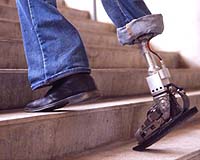| . |  |
. |
Raleigh, NC (SPX) Feb 18, 2010 A "metal foam" that has a similar elasticity to bone could mean a new generation of biomedical implants that would avoid bone rejection that often results from more rigid implant materials, such as titanium. Researchers at North Carolina State University have developed the metal foam, which is even lighter than solid aluminum and can be made of 100 percent steel or a combination of steel and aluminum. In a new paper, researchers have reported recent findings that, in addition to the extraordinary high-energy absorption capability and light weight of their novel composite foams, the "modulus of elasticity" of the foam is very similar to that of bone. Modulus of elasticity measures a material's ability to deform when pressure is applied and then return to its original shape when pressure is removed. The rough surface of the foam would also foster bone growth into the implant, improving the strength of implant. Modulus of elasticity, which is measured in gigapascals (GPa), is extremely important for biomedical implants, explains Dr. Afsaneh Rabiei, an associate professor of mechanical and aerospace engineering and an associate faculty member of biomedical engineering at NC State and co-author of the paper. "When an orthopedic or dental implant is placed in the body to replace a bone or a part of a bone, it needs to handle the loads in the same way as its surrounding bone," Rabiei says. "If the modulus of elasticity of the implant is too much bigger than the bone, the implant will take over the load bearing and the surrounding bone will start to die. This will cause the loosening of the implant and eventually ends in failure. This is known as "'stress shielding.'" When this happens, the patient will need a revision surgery to replace the implant. Our composite foam can be a perfect match as an implant to prevent stress shielding," Rabiei explains. To give an idea of the difference between the modulus of elasticity of bone and that of traditional implants, bone has a modulus of between 10 and 30 GPa - while titanium has a modulus of approximately 100 GPa. The new composite foam has a modulus that is consistent with bone, and is also relatively light because it is porous. The rough surface of the metal foam, Rabiei says, "will bond well with the new bone formed around it and let the body build inside its surface porosities. This will increase the mechanical stability and strength of the implant inside the body." The research, "Evaluation of modulus of elasticity of composite metal foams by experimental and numerical techniques," was funded by the National Science Foundation and will be published in the March issue of Materials Science and Engineering A. The research was co-authored by Rabiei and former NC State Ph.D. student L. Vendra.
Share This Article With Planet Earth
Related Links North Carolina State University All About Human Beings and How We Got To Be Here
 Amputees struggle in Taliban-torn Pakistan
Amputees struggle in Taliban-torn PakistanPeshawar, Pakistan (AFP) Feb 17, 2010 Laiba is only seven years old, but she's a poster girl for thousands of Pakistanis who have lost limbs in the war between Islamist militants and the armed forces. The girl, whose name means "Fairy of the Heavens", was shopping in Peshawar with her uncle for a new pair of socks for the Muslim festival of Eid in November 2008 when tragedy struck. Their car was travelling alongside a convoy ... read more |
|
| The content herein, unless otherwise known to be public domain, are Copyright 1995-2010 - SpaceDaily. AFP and UPI Wire Stories are copyright Agence France-Presse and United Press International. ESA Portal Reports are copyright European Space Agency. All NASA sourced material is public domain. Additional copyrights may apply in whole or part to other bona fide parties. Advertising does not imply endorsement,agreement or approval of any opinions, statements or information provided by SpaceDaily on any Web page published or hosted by SpaceDaily. Privacy Statement |